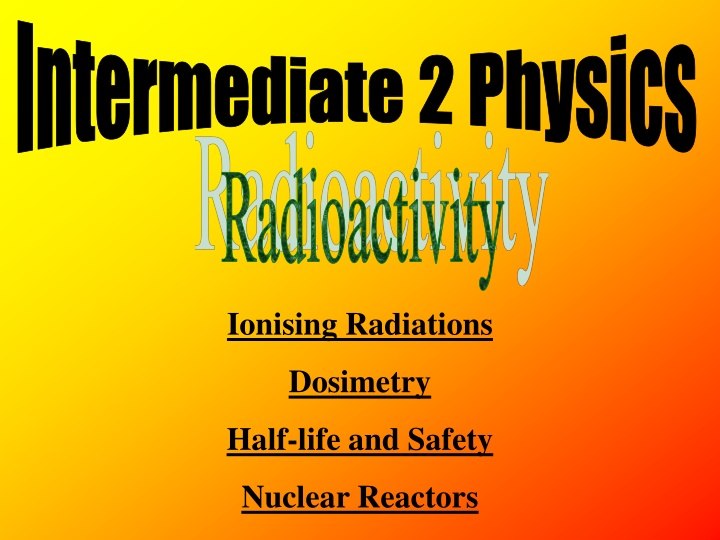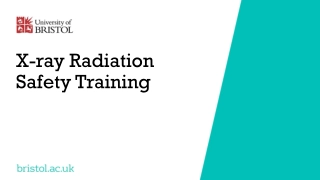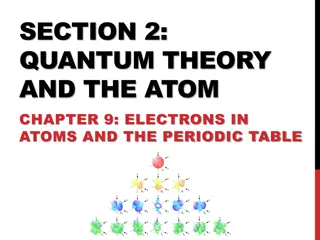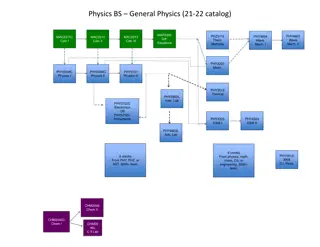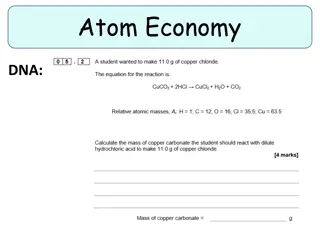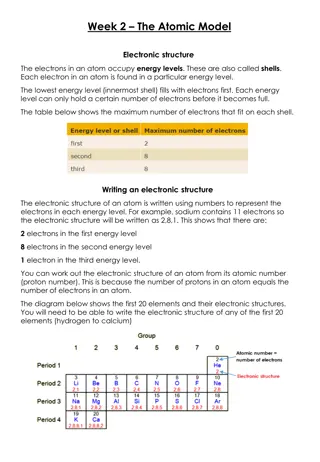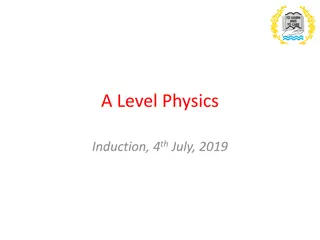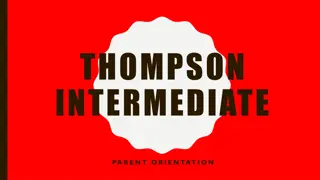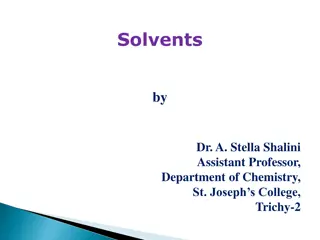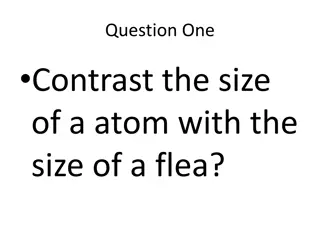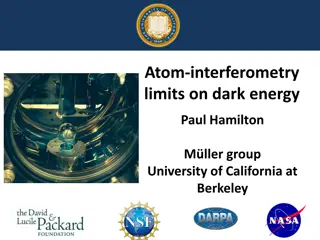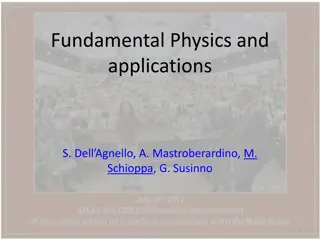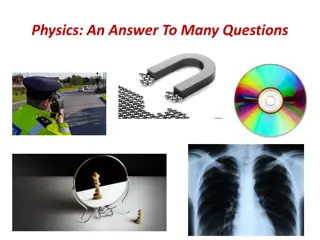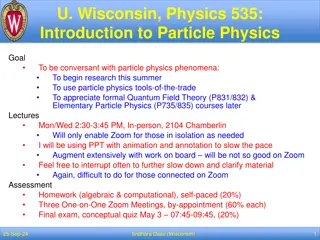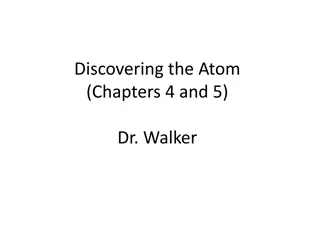Intermediate 2 Physics: Exploring Ionising Radiations and Atom Structure
In the study of Intermediate 2 Physics, delve into the intricacies of ionising radiations and the components of an atom. Understand the phenomena of ionisation, electron gain or loss, and the concept of ions. Explore the nature of nuclear radiation types - alpha, beta, and gamma particles. Gain insights into how atoms can undergo changes in their charge through gaining or losing electrons.
Download Presentation

Please find below an Image/Link to download the presentation.
The content on the website is provided AS IS for your information and personal use only. It may not be sold, licensed, or shared on other websites without obtaining consent from the author.If you encounter any issues during the download, it is possible that the publisher has removed the file from their server.
You are allowed to download the files provided on this website for personal or commercial use, subject to the condition that they are used lawfully. All files are the property of their respective owners.
The content on the website is provided AS IS for your information and personal use only. It may not be sold, licensed, or shared on other websites without obtaining consent from the author.
E N D
Presentation Transcript
Intermediate 2 Physics Radioactivity Ionising Radiations Dosimetry Half-life and Safety Nuclear Reactors
Intermediate 2 Physics Radioactivity Ionising Radiations Dosimetry Half-life and Safety Nuclear Reactors Ionising Radiations Dosimetry Half-life and Safety Nuclear Reactors
Ionising Radiations Ionising Radiations The atom is made of three main components: protons, neutrons and electrons. At the centre of the atom is the nucleus which is made up of neutrons and protons. The electrons are considered to be in orbits around this nucleus. Protons are positively charged. Neutrons are neutral. Electrons are negatively charged.
Electron (-) Proton(+) Neutron This atom has as many positive protons as it has negative electrons it is therefore overall neutral.
If the atom was to lose one or more electrons, it loses negative charge.
If the atom was to lose one or more electrons, it loses negative charge. The atom then has less electrons than protons. The atom now has an overall positive charge.
If the atom was to gain one or more electrons, it gains negative charge.
If the atom was to gain one or more electrons, it gains negative charge. The atom then has more electrons than protons. The atom now has an overall negative charge.
a neutral atom An atom can be forced to gain or lose electrons from the orbits around the nucleus when put in the path of a radioactive particle or wave. This gain or loss of electrons is called ionisation . An atom carrying a non neutral charge is known as an ion . a positive ion
There are three types of nuclear radiation: alpha ( ) beta ( ) gamma ( ) Alpha particles are helium nuclei. They both have 2 neutrons and 2 protons, and are therefore positive. 4 2 Alpha particles have the symbol: Beta particles are fast moving electrons which come from within the nucleus of the atom. (A neutron splits into a proton and an electron) 0 -1 Beta particles have the symbol: Gamma rays are caused by energy changes in the nuclei. They have no mass or charge. These rays are electromagnetic radiation which carries energy from the nucleus. Gamma rays have the symbol:
The three nuclear radiations , are called ionisingradiations because they can produce ions in the medium through which they pass. Alpha particles produce a much greater ionisation density than beta particles or gamma rays. The energy of the or may be absorbed in the medium through which they pass. Alpha particles can be absorbed by a thin piece of paper or roughly 5 cm of air. Beta particles can be absorbed by a few mm of aluminium or several metres of air. Gamma waves can only be absorbed by a few cm of lead. Even a thick piece of lead may not absorb all the gamma rays!
Absorption of alpha, , beta, and gamma, Thin piece of paper Few mm of aluminium Few cm of lead
Radiation will fog photographic plates. This is used in film badges, used to monitor a worker s exposure to different types of radiation. Top view 0.3 mm aluminium 0.1 mm plastic Open Film badge Window 0.1 mm aluminium 1 mm lead Side view Windows Photographic film
By studying the level of fogging underneath each window, we can tell how much alpha, beta and gamma radiation the badge (and the person wearing it) has been exposed to. Top view 0.3 mm aluminium 0.1 mm plastic Open Film badge Window 0.1 mm aluminium 1 mm lead Side view Windows Photographic film
Ionising radiation, such as or , can kill or change the nature of living cells. This can have good effects as well as bad ones. The fact that radiation can kill living cells allows us to: 1. use radiation to sterilise instruments by killing the bacteria cells 2. treat cancer by radiotherapy, where the incident radiation kills the cancerous cells within the body. 3. use tracers in medicine or industry.
Radioactive material is easy to detect because of the radiation it gives out. Hospitals can use a radioactive tracer to study the working of various parts of the body. To do this they inject the patient with a radioactive source. This source is usually a gamma source, since gamma can be detected outside the body. The doctors would then use a gamma camera to follow the tracer around the patients body.
Return to start of Radioactivity Advance to next section
Return to start of Radioactivity Advance to next section
Dosimetry Dosimetry A radioactive source is said to have activity which is measured in becquerels (Bq). One becquerel is defined as one atom decaying per second. number of decays Activity = time taken The absorbed dose D is the energy absorbed per unit mass of the absorbing material. energy = Absorbed dose mass The gray (Gy) is the unit of absorbed dose and one gray (Gy) is one joule (J) per kilogram (kg).
The risk of biological harm from an exposure to radiation depends on three things: 1. the absorbed dose the kind of radiation e.g. or a slow neutron 2. 3. the body organs or tissue exposed. A quality factor Q is given to each kind of ionising radiation as a measure of its biological effect. The quality factor for is about 20. The quality factor for or is usually only 1. Note that Q has no units.
The equivalent dose is a very useful quantity when considering radiation hazards and radiation protection. Equivalent dose, H, is the product of absorbed dose, D, and quality factor , WR. H = D x WR Equivalent Dose, H is measured in sieverts (Sv) The average background radiation is about 2 mSv
Some sources of background radiation are given below. Cosmic radiation from the sun and outer space. Radioactivity from rocks and soil on the Earth s surface. Radioactive gases such as radon and thoron. Radioactivity which is naturally present in the human body.
Return to start of Radioactivity Advance to next section
Return to start of Radioactivity Advance to next section
Half Half- -life and Safety life and Safety A reminder: any radioactive source is said to have an activity which is measured in becquerels (Bq). One becquerel is defined as one atom decaying per second. number Activity = of decays time taken The activity of a radioactive source decreases with time. The half life is a more useful quantity. The half life is the time taken for one half of the nuclei in a sample to decay. If a radioactive source has a half-life of, say, two minutes. The rate at which it decays will reduce by one half every two minutes. For example ...
The count rate of a source is measured every minute for 10 minutes using a Geiger - M ller tube and counter. (The background count rate has been considered.) The results are shown below: time (s) count rate (counts/seconds) 1000 660 500 330 250 205 125 0 60 120 180 240 300 360 420 480 540 600 80 62 40 31 The results show that as time passes the count rate of the source is decreasing. How long does it take for the count rate to fall by one half? We usually need to plot a graph of results ..
Half-life graph 1200 Count rate (counts/second) 1000 800 600 400 200 0 0 100 200 300 time (s) 400 500 600 700 The graph can be used to find the half-life of the source.
Half-life graph 1200 Count rate (counts/second) 1000 800 600 480 400 200 0 t1 0 100 200 300 time (s) 400 500 600 700 Select a point on the line which crosses grid lines on both axes. At t1 the count rate = 480 counts/second
Half-life graph 1200 Count rate (counts/second) 1000 800 600 480 400 240 200 0 t1 t2 0 100 200 300 time (s) 400 500 600 700 Now find the point on the graph where the count rate is half the previous value, (one half of 480 is 240).
Half-life graph 1200 Count rate (counts/second) 1000 800 600 480 400 240 200 t1/2 0 t1 t2 0 100 200 300 time (s) 400 500 600 700 The half-life is the time taken for count rate to drop by half. t1/2 = t2 - t1 = 240 - 120 = 120 s = 2 minutes
It is sometimes possible to calculate the half-life of a source without using a graph. Example A source has an original activity of 12000 Bq. After 24 days the activity has dropped to only 750 Bq. What is the half life of the source? 12000 6000 3000 1500 750 2 3 1 4 half lives have passed in 24 days. 24 = 6 days One half life = 4
When working with radioactive substances be sure to follow these simple safety procedures: 1. Never point a radioactive source towards anyone (including yourself). 2. Always use forceps or tongs to handle sources. 3. Store sources in lead lined boxes. 4. Always label radioactive sources
Dose equivalent can be reduced by: 1. Shielding 2. Limiting the time of exposure 3. Increasing the distance from a source. The radioactive hazard sign looks like this This sign should be displayed wherever radioactive sources are stored and in areas where radioactive materials are used.
Return to start of Radioactivity Advance to next section
Return to start of Radioactivity Advance to next section
Nuclear Reactors Nuclear Reactors There are advantages for using nuclear power for the generation of electricity. Fossil fuels are running out, so nuclear power provides a convenient way of meeting our electrical energy needs. A nuclear power station needs very little fuel compared with a coal or oil-fired power station. One tonne of uranium provides 25000 times as much energy as one tonne of coal. Nuclear fuel does not pollute the atmosphere. Fossil fuels fill the air with carbon dioxide and sulphur dioxide when they burn. These gases are the cause of acid rain.
However there are disadvantages of using nuclear power for the generation of electricity. A serious accident in a nuclear power station is of disastrous consequence. The Chernobyl disaster is an example of this. Nuclear power stations produce radioactive waste, this waste can be very difficult to dispose of safely. After twenty or thirty years the nuclear power stations themselves will have to be demolished and disposed of appropriately.
Energy is produced in a nuclear reactor by a process called fission. Fission is when the nucleus of a radioactive atom is hit by a neutron which causes the nucleus to split. As the nucleus splits it emits energy and it also usually emits another 3 neutrons. neutron Uranium nucleus
Energy is produced in a nuclear reactor by a process called fission. Fission is when the nucleus of a radioactive atom is hit by a neutron which causes the nucleus to split. As the nucleus splits it emits energy and it also usually emits another 3 neutrons.
Energy is produced in a nuclear reactor by a process called fission. Fission is when the nucleus of a radioactive atom is hit by a neutron which causes the nucleus to split. As the nucleus splits it emits energy and it also usually emits another 3 neutrons. Energy neutrons new nuclei
A chain reaction is when the neutrons released, due the splitting of the nucleus, go on to hit more nuclei, creating more energy and more neutrons. These neutrons then hit more nuclei producing even more energy and even more neutrons which go on to hit more nuclei. The level of energy that can be produced in this uncontrolled chain reaction is huge. This is the principle use in an atomic bomb.
A nuclear power station uses a controlled chain reaction to produce energy. The fission process is controlled by only allowing on average one new neutron, produced when a nucleus splits, to go on to cause another nucleus to split and produce energy. If the process was not controlled the energy produced would snowball out of control and cause a nuclear meltdown . To control the whole process, control rods (normally made of boron) are used to absorb the excess neutrons.
The nuclear reactor: Boron control rods Concrete containment vessel Uranium fuel rods Hot gas out Steam Heat exchanger Cold water Graphite moderator Gas coolant
The fuel rods are made of natural uranium enriched with uranium 235 which produce more energy by fission. The moderator, normally made of graphite, has the fuel rods imbedded in it. The purpose of the moderator is to slow down neutrons that are produced in fission. A nucleus is split more easily by slow neutrons. The control rods are normally made of boron, they control the rate of production of energy. In the event of an emergency the boron rods are pushed into the core of the reactor and the chain reaction stops completely.
A cooling system is needed to cool the reactor and to transfer heat to the boilers in order to generate electricity. British gas -cooled reactors use carbon dioxide gas as a coolant The containment vessel is made of thick concrete which acts as a shield to absorb neutrons and other radiations. The disposal of radioactive waste can be troublesome. Waste products from nuclear power stations can have a half-life of hundreds of years. They have to be stored in concrete and steel containers before being buried deep underground or dropped to the bottom of the ocean.
